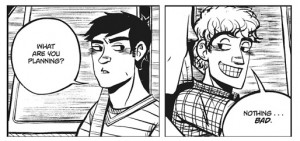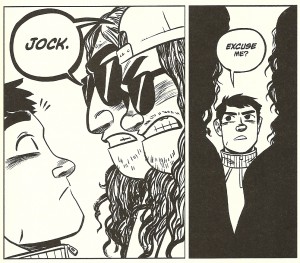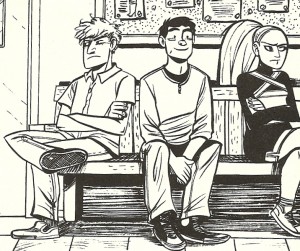Welcome to Using Graphic Novels in Education, an ongoing feature from CBLDF that is designed to allay confusion around the content of graphic novels and to help parents and teachers raise readers. In this column, we examine graphic novels, including those that have been targeted by censors, and provide teaching and discussion suggestions for the use of such books in classrooms.
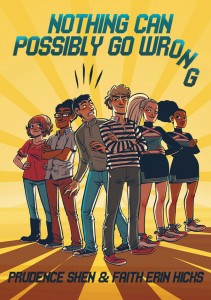 Honoring Women’s History Month, we highlight a wonderful young adult book that is written by women about bending stereotypes, Nothing Can Possibly Go Wrong by Prudence Shen and Faith Erin Hicks (First Second Books, 2013).
Honoring Women’s History Month, we highlight a wonderful young adult book that is written by women about bending stereotypes, Nothing Can Possibly Go Wrong by Prudence Shen and Faith Erin Hicks (First Second Books, 2013).
Nothing Can Possibly Go Wrong is a graphic novel adapted and drawn by Faith Erin Hicks from the young adult novel Voted Most Likely by Prudence Shen. It’s full of unlikely friendships and nicely nuanced characters who bend and shatter stereotypes and expectations. The central characters are Charlie Nolen, captain of Hollow Ridge High School basketball team and his (best) friend Nate Harding, president of the robotics club. In a twist of fate, the robotics club and the cheerleaders are vying for student council funding. In an effort to win the funding, Charlie decides to run for student council president. The “Gestapo” cheerleaders decide to have Nate run against him with the hopes that they can manipulate Nate into funding their new outfits and not the robotics club. And while each group is convinced that their strategies are flawless, things don’t work out the way anyone had planned.
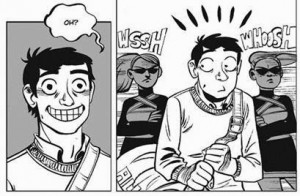 In the midst of everything, Charlie must deal with his divorced parents, and he must examine what it is he really wants. Nate and the cheerleaders must do the same. The book is all about friendships, cooperation, heartbreak, and the myopic pursuit of goals versus creative thinking. Along the way, there are break-ups, disappointments, and lots of fun.
In the midst of everything, Charlie must deal with his divorced parents, and he must examine what it is he really wants. Nate and the cheerleaders must do the same. The book is all about friendships, cooperation, heartbreak, and the myopic pursuit of goals versus creative thinking. Along the way, there are break-ups, disappointments, and lots of fun.
Aside from the interesting story weaving high school basketball, cheerleading, and robot rumbles, it’s the nuanced characters that really make Nothing Can Possibly Go Wrong fun and different. And these characters are developed both in the text and in the way they’re drawn, dressed, and artfully designed. Each and every one of them is full of contradictions that empower them to bend and break their stereotypic roles along with the reader’s expectations. The popular jock gives into his unhappiness; the nerd flips between being sympathetic and manipulative while being blindly driven. The cheerleaders are kick-ass Machiavellian but not at all shallow. They, like the nerd, are focused in their efforts to reach their goals. And then there’s the cute Joanna, who is one ruthless robot driver, welder, and science geek who helps Charlie find his way again.
BRIEF CHARACTER OVERVIEW
Nate Harding is a bit of a nerd, who happens to live down the block from and is friends with Charlie Nolan, the captain of the Hollow Ridge High School basketball team. Nate builds robots. He’s president of the Science Club and hangs out with his fellow roboteers — Ben, Joanna, and “the twins.” Nate is a determined, focused kid who makes things happen. And yet, he has a bit of a persecution complex. At one point Nate tallies the number of times he’s been shoved into lockers, tripped in the hallway, “accidentally” smacked by backpacks, and had muttered insults slung at him by basketball players, cheerleaders, and the “people sucking up to them.” But the awesome thing about Nate is that even with his persecution complex, he will do just about anything to get funding for the Robot Club.
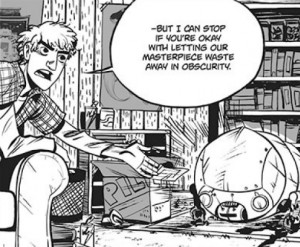 Charlie, on the other hand is a jock, who despite his popularity easily succumbs to his unhappiness. The book opens with Holly the head cheerleader breaking up with Charlie, and Nate saying that’s not possible because, “It’s an iron-clad high school rule you date Holly to make the rest of us less-attractive-but-infinitely-smarter mortals hate you.” As the book goes on, we gradually pick up more and more clues of an unhappy and somewhat dysfunctional family situation distracting and upsetting Charlie. His family situation and his being torn between his friend Nate and his fear of the cheerleaders lead Charlie into a bind he’s trying to avoid.
Charlie, on the other hand is a jock, who despite his popularity easily succumbs to his unhappiness. The book opens with Holly the head cheerleader breaking up with Charlie, and Nate saying that’s not possible because, “It’s an iron-clad high school rule you date Holly to make the rest of us less-attractive-but-infinitely-smarter mortals hate you.” As the book goes on, we gradually pick up more and more clues of an unhappy and somewhat dysfunctional family situation distracting and upsetting Charlie. His family situation and his being torn between his friend Nate and his fear of the cheerleaders lead Charlie into a bind he’s trying to avoid.
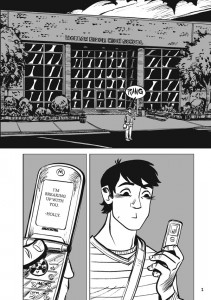 The cheerleaders and Nate’s fellow roboteers, while supporting characters, are no less interesting. They are developed through a combination of art and text and help drive, explain, and contradict all our expectations. For example, to help supplement the story and help us acquire an understanding of the cheerleaders, Faith Erin Hicks uses an aggressive uniform design, which are intentionally black to help make them look like a squad of ninjas. Holly (Charlie’s now ex-girlfriend) also has a ponytail that resembles a Roman centurion’s helmet — again letting us know she is ruthless and powerful, with a cool depth to her that is not to be toyed with. Holly clearly stands up and works for what she wants.
The cheerleaders and Nate’s fellow roboteers, while supporting characters, are no less interesting. They are developed through a combination of art and text and help drive, explain, and contradict all our expectations. For example, to help supplement the story and help us acquire an understanding of the cheerleaders, Faith Erin Hicks uses an aggressive uniform design, which are intentionally black to help make them look like a squad of ninjas. Holly (Charlie’s now ex-girlfriend) also has a ponytail that resembles a Roman centurion’s helmet — again letting us know she is ruthless and powerful, with a cool depth to her that is not to be toyed with. Holly clearly stands up and works for what she wants.
SUMMARY
The book opens with Nate giving Charlie a lift home from school. Charlie has just received a text from Holly, breaking up with him. Nate, meanwhile, is blindly focusing on how upset he is at finding out that Holly and “her evil fembot co-captain Nola” want to take funding from the robotics competition to fund new cheerleader uniforms. Principal Getty has just decided to let the student council decide who gets the available funds: the cheerleaders or the robotics club. Charlie decides to weigh the odds in his favor by running for student council president. While his fellow teammates try to convince him that the election is merely a popularity contest he can’t possibly win, Nate is absolutely determined and convinced that nothing can possibly go wrong.
The cheerleaders also decide to enter Charlie in the race, thinking Charlie can’t say “no” to them. This puts Charlie in an awkward position and some dirty politicking. Charlie smartly stays out, of it letting the cheerleaders and Nate slug it out. Things, however, get so dirty and unsavory, that Principal Getty informs BOTH teams that they went too far and as a result have been dropped from any possible school funding.
At this point, Joanna, just wants to knock the crap out of Nate. But, “the twins” (whose names we only learn at the end of the book), have a more productive idea: They suggest that they might get funding by competing and winning a “Robot Rumble” that takes place on Thanksgiving. First and second places will win them a ton of money that will more than meet their funding needs for the robotics club.
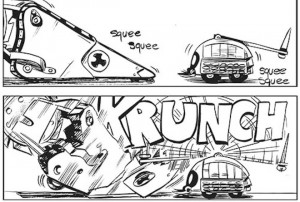 There are two minor problems with this idea. First, the Robot Rumble involves robots tearing each other apart. IF they don’t win — and even if they do win — their robot may be seriously damaged, if not totally disabled. Second, they don’t have enough funds to reinforce “The Beast” (their robot) from possible rumble damage or to even enter the rumble itself.
There are two minor problems with this idea. First, the Robot Rumble involves robots tearing each other apart. IF they don’t win — and even if they do win — their robot may be seriously damaged, if not totally disabled. Second, they don’t have enough funds to reinforce “The Beast” (their robot) from possible rumble damage or to even enter the rumble itself.
Meanwhile, while dealing with his mom’s leaving, his parents subsequent divorce, and his mom’s recent announcement of her engagement to another man, Charlie comes up with a solution for his friends: have the cheerleaders invest in The Beast. If The Beast were to win, there’d be more than enough prize money to fund both the robotic teams’ entry and trip to the Robot Competition AND fund the cheerleaders’ new uniforms. IF, of course, The Beast were to win the rumble.
The rest of the story is up to you to read and enjoy.
In short, Nothing Can Possibly Go Wrong is about friendship, dirty politics, rumbling robots, basketball, cheerleading, and family.
In addition to wonderfully nuanced characters and the wacky bending of expectations and stereotypes, the story relays:
- That there is more to the simple stereotypes of Jocks, Geeks, Nerds, Cheerleaders (to name a few);
- The power of friendship, especially when things get tough;
- How dirty, even in high school, politics can become;
- The power of persistence and cooperation with others to achieve your goals;
- That navigating social hierarchies takes skill and insight;
- Popularity does not insure happiness; and
- Anyone can be bullied and anyone can be a bully.
TEACHING/DISCUSSION SUGGESTIONS:
Cultural Diversity, Civic Responsibilities, and Social Issues
- Define stereotypes your students come across in their lives. Discuss the pros and cons of using stereotypes and why they persist.
- Have the class describe/define social labels such as “Nerds,” “Jocks,” and Geeks,” and analyze how the characters in this book comply with and defy these definitions and expectations. Talk about how these expectations might be used and misused in your school.
- Discuss and define typical male and female roles and expectations. Analyze how the book’s characters meet and defy these expectations, and why.
- Follow and discuss how both sides effectively and ineffectively campaigned for student council president, making sure to include their use of posters, slogans, and strategies. Discuss how their approaches were similar and different to those of local political campaigns in your area.
Language, Literature, and Language Usage
- Search for, and discuss the book’s use of alliteration, simile and metaphor. Discuss how these literary tools help the authors relay details and nuances in the story’s characters and plot.
- Discuss the derogatory words the kids use to describe others (i.e. “Gestapo cheerleaders,” “hoochie-forms,” and “evil fembot co-captain,” to name a few).
- Discuss why your students think the twins were not given names until the end of the book. How did this affect the story and the way we perceive them?
- Chart and analyze the slogans used by Nate and by the cheerleaders. Discuss how they help and/or hurt their political positions.
- Discuss the various team and robot names at the Robot Rumble. Have students discuss team and robot names they would use and why.
Critical Thinking and Inferences
The authors make many inferences in this book both with language use and through imagery. You may want to discuss the following uses of inference:
- This book is all about navigating socially in high school. Have students come up with their own “handbooks” or unofficial social rules of high school (or middle school depending on the age/grade of your students).
- Charlie’s solution for both teams’ financial issues is for the cheerleaders to invest in The Beast in the hope that The Beast places first and the prize money they receive will more than pay for the respective teams’ needs. Discuss and evaluate the risks versus the benefits of this strategy. Would you do it?
- There are a number of political/historical references made by Nate regarding the cheerleaders. Find and discuss them. (For example: On page 28, Nate tells Charlie, “You’re such a mess. They’re cheerleaders, not the KGB.”)
- After going too far and destroying the football field, Holly tells Principal Getty, “What we did was in extremely poor judgment and taste, but we were obeying the spirit of the electoral process.” Discuss the inferences and implications of this statement and how they were or were not “obeying the spirit of the electoral process.”
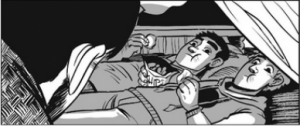 Modes of Storytelling and Visual Literacy
Modes of Storytelling and Visual Literacy
In graphic novels, images are used to relay messages with and without accompanying text, adding additional dimension to the story. Compare, contrast, and discuss with students how images can be used to relay complex messages. For example:
- Discuss how posters are designed and then used during the campaign. Analyze the images as well as the choice of words and slogans.
- On page 50, Nate says to Charlie, “Breathe. I hardly think the Pom-Pom Gestapo can do anything to you. Discuss the author’s choice of words and the imagery they relay. Then search the book and see how the illustrations further relay this image.
- To get to the Robot Rumble, Charlie, Nate, Ben, Joanna, the twins, Holly, and Nora drive from Hollow Ridge to Atlanta. On pages 196-197, we are told that the kids “argued vociferously (for 15 minutes) about the best way to get onto the highway.” Using various maps (NOT on the computer), plot how you might drive. Discuss where you might stop and why.
- Discuss the effective design of the Robot Rumble poster. Make sure to include the use of font, the use of the space and the choice of images used. How effective were these choices?
Suggested Prose and Graphic Novel Pairings
For greater discussion on literary style and/or content here are some prose novels and poetry you may want to read with The Silence of Our Friends
- The Hunger Games by Suzanne Collins — a story about Katniss Everdeen, a strong young woman who defies stereotypes.
- Friends with Boys by Faith Erin Hicks — for high school readers, a story about missing mothers, distant brothers, high school, and new friends.
- The Adventures of Superhero Girl by Faith Erin Hicks — about a superhero girl who loves kittens and battles monsters and the mundane.
- I’d Tell You I Love You, But Then I’d Have to Kill You (Gallagher Girls Series) by Ally Carter — about Carrie Morgan, a sophomore at an elite spy-training school who has no idea what to do when she meets an ordinary guy who thinks she’s ordinary as well.
- The Outsiders by S.E. Hinton — a story about the social divisions among kids and the mechanisms that drive their rivalry.
- The Chocolate War by Robert Cormier — a story about a kid who defies social convention in his school and the subsequent fallout from his actions.
- American Born Chinese by Gene Luen Yang — a graphic novel that explores stereotypes and adolescent worries over perception and acceptance.
- The Absolutely True Story of a Part Time Indian by Sherman Alexie — about a bright motivated young Native American who must decide between a long commute to a better all-white school off the reservation (and face ridicule from white kids he must befriend and from his local friends he leaves behind) or to remain with his friends at the reservation’s limited high school and head nowhere fast.
Common Core State Standards:
Nothing Can Possibly Go Wrong is full of advanced vocabulary, wonderful wordplay, inferences, nuanced characters, and humor. It does have some cursing but can be effectively used with mature middle and high school students. It promotes critical thinking and its graphic novel format provides verbal and visual story telling that addresses multi-modal teaching, and meets Common Core State Standards. As it can be used for a range of ages and grade levels, we discuss below how it meets various Common Core Anchor standards.
- Knowledge of Language: Apply knowledge of language to understand how language functions in different contexts, to make effective choices for meaning or style, to comprehend more fully when reading or listening.
- Vocabulary Acquisition and Use: Determine or clarify the meaning of unknown and multiple-meaning words and phrases by using context clues, analyzing meaningful word parts, and consulting general and specialized reference materials; demonstrate understanding of figurative language, word relationships, and nuances in word meaning; acquire and use accurately a range of general academic and domain-specific words and phrases sufficient for reading, writing, speaking and listening at the college and career readiness level.
- Key ideas and details: Reading closely to determine what the texts says explicitly and making logical inferences from it; citing specific textual evidence when writing or speaking to support conclusions drawn from the text; determining central ideas or themes and analyzing their development; summarizing the key supporting details and ideas; analyzing how and why individuals, events, or ideas develop and interact over the course of the text.
- Craft and structure: Interpreting words and phrases as they are used in a text, including determining technical, connotative, and figurative meanings and analyzing how specific word choices shape meaning or tone; analyzing the structure of texts, including how specific sentences, paragraphs and larger portions of the text relate to each other and the whole; Assessing how point of view or purpose shapes the content and style of a text.
- Integration of knowledge and ideas: Integrate and evaluate content presented in diverse media and formats, including visually…as well as in words; delineate and evaluate the argument and specific claims in a text, including the validity of the reasoning as well as the relevance and sufficiency of the evidence; analyze how two or more texts address similar themes or topics in order to build knowledge or to compare the approaches the authors take
- Range of reading and level of text complexity: Read and comprehend complex literary and informational texts independently and proficiently
- Comprehension and collaboration: Prepare for and participate effectively in a range of conversations and collaborations with diverse partners, building on others’ ideas and expressing their own clearly and persuasively; integrate and evaluate information presented in diverse media and formats, including visually, quantitatively and orally; evaluate a speaker’s point of view, reasoning, and use of evidence and rhetoric.
ADDITIONAL RESOURCES:
- http://www.nothingcanpossiblygowrong.com/: The book’s website, offering author and cartoonist insights, with the first 23 pages of the book and alternate ending options
Meryl Jaffe, PhD teaches visual literacy and critical reading at Johns Hopkins University Center for Talented Youth Online Division and is the author of Raising a Reader! and Using Content-Area Graphic Texts for Learning. She used to encourage the “classics” to the exclusion comics, but with her kids’ intervention, Meryl has become an avid graphic novel fan. She now incorporates them in her work, believing that the educational process must reflect the imagination and intellectual flexibility it hopes to nurture. In this monthly feature, Meryl and CBLDF hope to empower educators and encourage an ongoing dialogue promoting kids’ right to read while utilizing the rich educational opportunities graphic novels have to offer. Please continue the dialogue with your own comments, teaching, reading, or discussion ideas at meryl.jaffe@cbldf.org and please visit Dr. Jaffe at http://www.departingthe text.blogspot.com.
We need your help to keep fighting for the right to read! Help support CBLDF’s important First Amendment work by visiting the Rewards Zone, making a donation, or becoming a member of CBLDF!
All images (c) Faith Erin Hicks.
